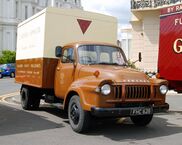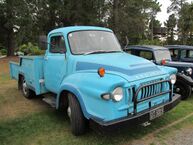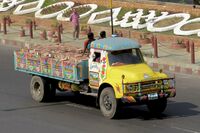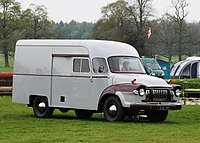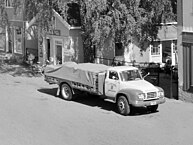Engineering:Bedford TJ
| Bedford TJ | |
|---|---|
 1966 Bedford TJ | |
| Overview | |
| Manufacturer | Bedford AWD Trucks Marshall Aerospace & Defence Group |
| Also called | AWD-Bedford TJ |
| Production | 1958–1998 |
| Assembly |
|
| Body and chassis | |
| Class | Medium-duty truck |
| Related | Bedford TA |
| Dimensions | |
| Wheelbase | 2,960–3,508 mm (116.5–138.1 in) |
| Length | 5,380–6,560 mm (211.8–258.3 in) |
| Width | 80–90 in (2,032–2,286 mm) |
| Height | 107–112 in (2,700–2,800 mm) |
| uk|uk|Kerb|Curb}} weight | 4,893–19,829 lb (2,219–8,994 kg) |
| Chronology | |
| Predecessor | Bedford TD |
The Bedford TJ is a truck that was produced by Bedford and its successors from 1958 to 1998, as a replacement for the earlier Bedford A series of medium-duty trucks that were built between 1953 and 1958. The TJ was the last bonneted truck produced by the company, and the last vehicle to be produced to have a relation with Bedford.
History
Production of the Bedford TJ began in 1958 as Bedford’s new bonneted truck model, and was a modernised version of the Bedford TD series, modelled after the Chevrolet Advance Design truck. The TJ truck was produced in many versions, ranging from light pickups to heavy-duty vehicles, with payloads up to 6-8 tons. Unfortunately, due to their relatively dated styling and presumably since bonneted trucks were falling out of favor these years, the TJ series was not very popular in the United Kingdom and did not sell in big numbers, with the exception of the AA and Post Office Telephones. In particular, Holland's Pies in Lancashire used a large fleet of TJ vans well into the 1980s, being notable for being kept in very clean condition and this resulted in the TJ being often called a 'Holland's pie van' around Lancashire.[1]
The lightest versions (J0) shared the same petrol engine as the Vauxhall Cresta, which offered relatively good performance, although it could not cope very well with loads over 800-900 kg.[2] Heavier variants used the same engine as on the Bedford TD series. In export markets, specifically in countries such as India, Pakistan, Africa and other developing nations, the TJ sold in great numbers due to its reliability and relatively low price compared to the competition. In 1975, the TJ was withdrawn from the UK market and superseded by the Bedford CF.[3][4][5][self-published source?]
After 1975, the TJ was offered only for export where it was pretty successful, however, during the 1980s, exports to countries such as Australia and New Zealand stopped since it was clear that these trucks were very outdated, and couldn't compete in the market anymore due to changing emissions and regulations. Nevertheless, it continued production for export to developing countries. In 1987, the Dunstable plant was sold to David J.B. Brown and became AWD Trucks.[6] Production of the TJ continued under the AWD Bedford badge. After Marshall SPV purchased AWD Trucks, production of the TJ series continued, but in limited numbers. The last TJ trucks were built in 1998, when an order was placed for 100 trucks to be exported to Kenya.[7]
Pakistan
In Pakistan, the J5/6 is very popular and dominated commercial vehicular traffic. It has a cult status among drivers and is known for its power, reliability, and durability. Over 50% of the trucks in Pakistan are Bedford vehicles.[8]
India
An Indian company, Hindustan Motors, also produced the larger versions (J5/6) of the vehicle in that country from 1968. Production lasted for three decades, but the vehicle proved to be unable to compete with Tata and Ashok Leyland vehicles and was finally discontinued in 1998.[9]
Australia
The TJ was widely exported. In Australia they were distributed by Holden.
Malaysia
Bedford TJ trucks were also produced in Malaysia from knock-down kits until the early 1980s. Towards the end of this period, after Bedford vehicles had lost their market lead, the TJ shared the assembly line with competing trucks from Toyota.[10] As the design aged, Bedford's reputation shrank, the British Pound went up, while Britain itself lost much of its standing in Malaysia.[10] GM instead chose to focus more on promoting trucks from corporate stablemate Isuzu in that market. The TJ trucks were replaced by the Isuzu TX trucks.
Models
- J0 (often referred to as JO)
- J1
- J2
- J3
- J4
- J5
- J6
Chassis codes
1958 To June 1967
- J1 30cwt.
- J2S 3ton.
- J2L 3ton. (GVM - 5ton)
- J2LC 3ton (GVM - 4.5ton)
- J3L 4ton.
- J4L 5ton.
- J4E 5ton.
- J4A 8ton tractor.
- J5S 6ton.
- J5L 6ton.
- J6S 7ton.
- J6L 7ton.
A 3rd or 4th number indicates engine type;
- 1 = 300cu. in Diesel
- 2 = 214cu. in Petrol
- 3 = 300cu. in Petrol
- 5 = 330cu. in Diesel
- 7 = 200cu. in Diesel
- 10 =220cu. in Diesel
July 1967 onwards
Chassis codes changed in July 1967 to ensure Bedford complied with new legislation introduced in the UK (Construction and Use Regulations).
- CDD/CHD 30cwt.
- CDJ/CHJ 3ton.
- CDL/CHL 4ton.
- CFM/CJM 5ton.
- CFN/CJN 6ton.
- CFQ/CJQ 7 ton.
The 3rd letter is for the weight rating, while the 2nd letter indicates engine type;
- D = 214cu. in Petrol
- F = 300cu. in Petrol
- H = 220cu. in Diesel
- J = 330cu. in Diesel
Engines
The engines available included:
| Available engines (outputs are gross numbers unless otherwise specified) | |||||
|---|---|---|---|---|---|
| Displacement | Bore x Stroke | Cylinders | Power/rpm | Torque/rpm | Fuel |
| 214.7 cu in (3,519 cc) |
3.375 in × 4.00 in (85.7 mm × 101.6 mm) |
Inline-six | 100 bhp (75 kW) at 3,600 |
184 lb⋅ft (249 N⋅m) at 1,200 |
Petrol |
| 300.7 cu in (4,927 cc) |
3.875 in × 4.25 in (98.4 mm × 108.0 mm) |
133 bhp (99 kW) at 3,000 |
267 lb⋅ft (362 N⋅m) at 1,200 | ||
| 200.5 cu in (3,285 cc) |
3.875 in × 4.25 in (98.4 mm × 108.0 mm) |
Inline-four | 57 bhp (43 kW) at 2,600[lower-alpha 1] |
139 lb⋅ft (188 N⋅m) at 1,400[lower-alpha 1] |
Diesel |
| 220.5 cu in (3,614 cc) |
4.0625 in × 4.25 in (103.2 mm × 108.0 mm) |
70 bhp (52 kW) at 2,800 |
157 lb⋅ft (213 N⋅m) at 1,400 | ||
| 300.7 cu in (4,927 cc) |
3.875 in × 4.25 in (98.4 mm × 108.0 mm) |
Inline-six | 97 bhp (72 kW) at 2,800 |
217 lb⋅ft (294 N⋅m) at 1,400 | |
| 330.7 cu in (5,420 cc) |
4.0625 in × 4.25 in (103.2 mm × 108.0 mm) |
107 bhp (80 kW) at 2,800 |
238 lb⋅ft (323 N⋅m) at 1,800 | ||
Gallery
Bedford J5 box truck
The Bedford TJ trucks were also converted into buses in Cyprus
Bedford TJ with walk-through van body
See also
- Customised buses and trucks in Pakistan
References
- ↑ "The Bedford Register-the worlds largest owners club & registry". http://www.bedford-world.com/bedfordregister.htm.
- ↑ "Lot 191 - 1961 Bedford J.O. Pick-Up". https://www.historics.co.uk/buying/auctions/2018-05-19/cars/ref-95-1961-bedford-jo-pick-up/.
- ↑ http://vauxpedianet.uk2sitebuilder.com/bedford-97000---cf-cf2
- ↑ http://bedford-cf.co.uk/history.htm
- ↑ "Curbside Classic: 1977 Bedford CF Cab Chassis – Trying To Keep Up With The Transit". JOHNH875. https://www.curbsideclassic.com/blog/cc-capsule/cc-capsule-1977-bedford-cf-cab-chassis/.
- ↑ Clarke, Nicky, ed (1992-10-22). "AWD Survival In Civvies?". p. 17. https://archive.commercialmotor.com/article/22nd-october-1992/19/awd-survival-in-civvies.
- ↑ "1966 BEDFORD J-TYPE TRUCK". https://www.carandclassic.com/auctions/1966-bedford-j-type-truck-K8W338.
- ↑ "Bedford J5 'Jingle Truck'". https://www.imcdb.org/vehicle_1322414-Bedford-J5.html.
- ↑ Baron, Rich (3 June 2023). "Curbside Classic: 1970 Bedford TJ – Advanced Past Its Prime". https://www.curbsideclassic.com/uncategorized/curbside-classic-bedford-tj-advanced-past-its-prime/.
- ↑ 10.0 10.1 Millier, Noel (1982-05-22). "Malaysian malaise for once-proud Bedford". Commercial Motor 155 (3966): 83. https://archive.commercialmotor.com/article/22nd-may-1982/73/malaysian-malaise-for-once-proud-bedford.
External links
 |
